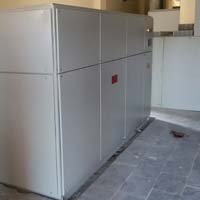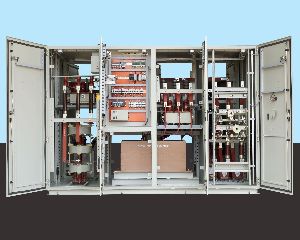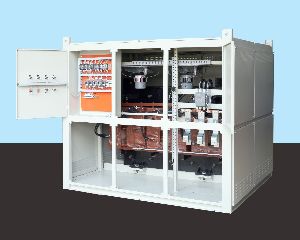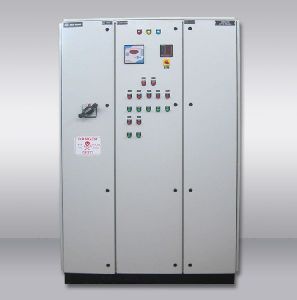
synchronous motor starters
Commissioned Biggest Starter in India. Induction start Synchronous run Motor application. Lowest starting current possible with special models. Tailored made for every individual Motors. Starting solutions offered instead of product . 6 times less economical than SFCVFD. Individual or common starter can be offered .
Type : Ac Synchronous Motors
Voltage : 440V
Condition : New, Used
Power : 1-3kw, 3-6kw, 6-9kw, 9-12kw
Driven Type : Electric
Phase : Three
Current Type : AC
Speed : 1000-2000rpm, 2000-3000rpm
Brand Name : ELTECH ENGINEERING
Frequency : 50Hz
...more
Soft Starter
1 Box (MOQ)
We are offering soft starter. Type: fcma iron core reactor technology. Rating : proven up to 16000kw,11kv.,capable up to 20mw,11kv. application : synchronous motors and induction motors.
...more
Slip Ring Starter
Owing to our wide distribution network and speedy delivery services, buyers can receive their orders on timely basis. We are a prominent name offering quality-centralized array of products that are the perfect outcome of premium raw material and modern work methods. Also, we source the material from the reliable places only.
...more
LV Soft Starters
We are offering lv soft starters. Low voltage starters up to 1000 kw from .2kw starting current : less than full load current. Application : compressor, industrial fan ,pump product is tailored made for customer requirements.
...more
Ht Capacitor
We are offering ht capacitor. Available up to 10mvar capacity with de tuned harmonic filters. Indoor and out door mounted.
...more
FCMA Soft Starter
FCMA type Magnetic Soft Starter offers series impedance in the motor circuit, usually constructed as a coil around laminated core of high permeability than that of air, which increases the magnetic field there by increasing the required starting impedance. Thus it reduces the starting current & torque of the motor & ensures the smooth starting. As motor speed increases due to counter emf feedback the starter impedance decreases, so the voltage drop across the Soft Starter. This result in incremental voltage & torque of the motor. As motor reaches to full speed the built in bypass device closes to ensure the full running voltage to the motor. The operation of bypass device can be done through set value of acceleration time, current or rated speed. Salient Features: Extremely rugged in construction. Suitable for extreme weather conditions like dusty and desert environment. No active electronic components involved. Starting current up to 1 P.U. Starting of motors with limited power. Built in bypass for full voltage during running. No external cooling required. Can be designed for multi motor starting. No harmonics generation- Zero Harmonics. Zero maintenance hence zero operations cost. CNC fabricated panel construction. Magnetic Flux Control technology. Range: 0.5 -20000 KW, 380 - 15000 V Data Required for Designing Starting Current: Motor Data sheet with details of : kW, I, V, F, N, PF, Effi. etc. Driven equipment / Application details Motor current - speed curve. Motor thermal withstand curve. Motor torque - speed curve. Load torque - speed curve. Motor Rotating Inertia (GD2). Load Rotating Inertia (GD2). Motor No. of starts per hour. Ambient condition. Grid Capacity/ Minimum SCC MVA Transformer / Generator capacity. Voltage drop limitations if any.
Weight : As FCMA Technology
Input Voltage : 415V to 15KV
Power : 10KW to 30000KW
Warranty : 1 Year to 5 Years
...more
Automatic Slip Regulator
In running some applications like Cane Fibrizor, Cane Cutter, Cane Chopper, Crushers , Mixers etc. experiences frequent kick loads / variable load due to uneven raw material feeding. This leads to overloading of the motor due to insufficient motor torque & causes nuisance tripping due to over current, which affects the process & results production loss. To avoid this, 15% fixed conventional buffer resistance is kept in the Motor Rotor circuit to deliver the high torque & to limit current kicks. This is useful when the motor is loading more than 100% for short time. When there is rated load or load less than the actual rating of motor then there is no need of 15% conventional Buffer Resistance in the Motor Rotor circuit. This resistance will create continuous power loss in the form of heat loss. Slip Regulator / Dynamic Buffer(DB) offers variable Resistance in the Rotor circuit due to slip dependent Resistance technology. When there is kick load / over load, then Slip Regulator offers Resistance instantaneously depending on slip at that load to its maximum value (upto 12 - 15%) & when the load is less than 100% of rated capacity or equal to rated capacity, then Slip Regulator offers 3 to 4% Resistance. This reduced value of Resistance during under load will help to save the power as compared to conventional Buffer Resistance. In Rotor Resistance Starter / Controller the part of resistance is kept in the Motor Rotor circuit continuously as a Slip Regulator / dynamic buffer to provide the required running torque to the applications which are experiencing the variable loads (like Crusher, Fibrizor in sugar Industries.) Depending on overloading pattern the speed tends to reduce which increases the slip frequency results to increase in resistance. As load goes down the slip frequency reduces results to reduce the resistance. Salient Features: Slip dependent Resistance provides automatic resistance variation during acceleration & running. Low Starting current. High starting torque. Built in Slip regulator contactor. No moving parts & stepless cutting of Resistance. No maintenance Applications: Sugar industry - Fibrisors, Cutters, Levellers & applications which requires high starting & running torque.
Input Voltage : 415V to 15KV
Power : 10KW to 6000KW
...more
Automatic Rotor Resistance Starter
Generally Slipring Induction Motors are used for applications which needs High Starting Torque & same is achieved by connecting additional starting resistance in the rotor circuit. The resistance needs to be reduced continuously in steps to increase the speed of the Motor so that the required torque is maintained. Slip dependent Rotor Resistance Starter / Controller are designed with lossy core & based on Rotor frequency dependant resistance design. This provides a low starting current with automatically reducing resistance which is inversely proportional to motor speed to provide enough starting torque & accelerate the motor with driven equipment to full speed smoothly without Electrical & Mechanical jerks. Slip dependent Rotor Resistance Starter is connected to the Rotor Terminals of the motor, so that the starting current is limited to a low value with a high starting torque. Motor acceleration is smooth, step less and jerk less, as resistance reduction is step less and automatic. After reaching motor to full speed, Rotor Starter will be out of circuit with the help of inbuilt bypass contactor and during running motor will be acting as Squirrel cage induction motor. These starters sense zero-speed automatically and offer high value (100%) of resistance at every new start. Thus avoid motor damage. The Rotor Starter is designed in such a way that the resistance offered by it is frequency dependent. When the motor starts from zero speed the rotor frequency equal to supply frequency and the Rotor Starter resistance is maximum. Salient Features: Slip dependant Resistance provides automatic resistance variation during acceleration. Low Starting current. High starting torque. Built in bypass contactor. No moving parts & stepless cutting of Resistance. No maintenance. Data Required for Designing Starting Current: Motor Data sheet with details of :- kW, I, V, F, N, PF, Effic, etc. Driven equipment / Application details. Motor Rotor Voltage (RV) & Rotor Current (RA). Motor thermal withstand curve. Motor current - speed curve. Motor torque - speed curve. Load torque - speed curve. Motor Rotating Inertia (GD2). Load Rotating Inertia (GD2). Motor No. of starts per hour. Ambient condition. Applications: Cement industry - Ball mills, Wagon unloaders, Cement mills, Conveyors etc… Steel industry - Ball mills, Conveyors etc… Mines - Crushers, Conveyors, Pumps etc… Sugar industry - Pumps, Fibrisors, Cutters, Levellers & applications which requires high starting torque.
Power : 10KW to 6000KW
Warranty : 1 Year to 5 Years
...more
APFC Panels
Generally AC system have three basic loads, i.e. resistive, inductive and capacitive. In case of purely resistive load, the current and voltage are in phase. Whereas, in case of inductive load, current lags behind the voltage. In industries, most of the equipment and appliances are inductive in nature. In case of capacitive load current leads the voltage. Mostly capacitors are installed for power factor correction of system . Inductive or capacitive loads are termed as the reactive loads. In this loads active power can only be consumed in resistive portion of load, where the current and voltage are in phase. Reactive component of the load consumes reactive power which is necessary for energizing the magnetic circuit of the equipment and is not useful for work. Inductive loads are with two current components, one is active current & another is reactive current. Vector sum of these two power components (active and reactive) is termed as Apparent Power (measured in kVA). The ratio of active power (kW) to apparent power (kVA) is known as power factor. In case of resistive load kVAr (reactive component) is absent, so angle φ will be zero degree, hence power factor will be unity. For a inductive load the power factor will be lagging and for capacitive load the power factor will be leading. Thus it is clear that, if the power factor is different than unity (low power factor), more will be the kVA demand for same kW load. Most of the HT tariffs include kVA Demand charges along with Energy Charges, more the kVA demand for the same kW load more will be the electricity bill to consumer. Disadvantages of Poor Power Factor: Load draws high current for same value of useful power 1. Which results in increase in size of the switchgear, cable, transformer etc. All this adds to the cost. 2. High current causes increased power loss (I2R loss) in the circuits. The conductor temperature increases and hence the life of insulation gets reduced. 3. It increases voltage drop which affects different loads as below: Reduces the illumination of lighting lamps. Heating devices operates at reduced temperature, results in increased consumption & process time. It leads to nuisance tripping of Induction motor on overload. Advantages of Improved Power Factor: Reduces losses in the system, cables, lines, and feeder circuits and hence lower sizes could be selected. Improves system voltage & helps to all types of load to operate at rated capacity with designed output. System capacity Increases (kVA) for the same kW, permits additional loading. Range: APFC panels with & without series reactor for any capacity LT & HT system.
Type : High and Low Voltage
Size : All Sizes
Application : All Industry Application
Voltage : 415v to 15kv
Color : As per Customer Specifications
...more
Motor Starter
Manufacturers of Soft Starters based out of FCMA Principle have proven installation up to 16000KW. Having provided for various application like compressor, Industrial FAN and Pump.
...more
synchronous motor starter

Ht Capacitors

Soft Starter Panel

High Voltage Capacitors

Slip Ring Motor Starter

Electric Motor Starter

Rotor Resistance Starter
Opening Hours